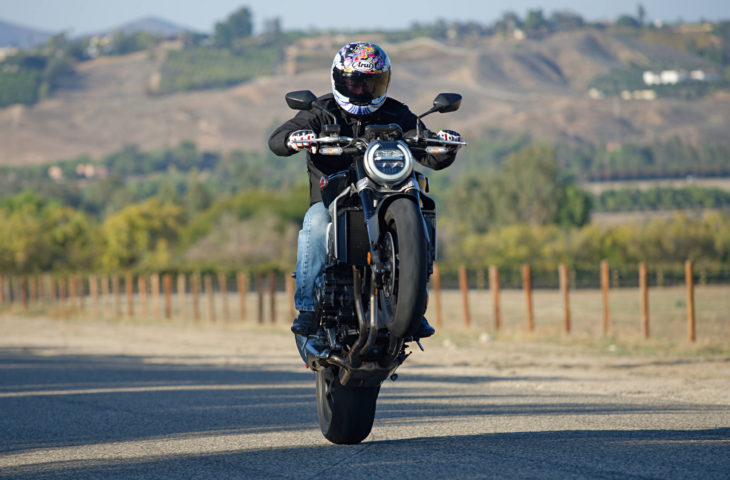
Honda is known for conservative styling … some would say boring. When it first displayed the Neo Sports Café concept in Tokyo last year, Honda telegraphed a new styling direction that took some risks, but was well received and generally considered attractive. A production version followed shortly thereafter in the form of the CB1000R which is the subject of this test. Loyal to the stunning concept, the production CB1000R is a looker, and certainly out of character for Honda. It isn’t strictly a retro, or a replica of a past model. It is a big step outside the box.
Mechanically, the bike combines some old with some new. Although it utilizes a prior generation 998cc inline-four, rather than an iteration of the latest Honda production superbike motor, Honda claims horsepower and torque are both increased from the outgoing CB1000R due to a number of internal changes. The compression ratio is up, valve timing has changed and new, forged pistons compress an air/fuel mixture fed by larger throttle bodies (a big increase – 36 mm to 44 mm). Final gearing is lower for an improvement in acceleration.
A new steel frame and a new exhaust system together lose more than 15 pounds. Honda claims the entire bike is 17 pounds lighter than the model it replaces. Claimed curb weight is 467 pounds with the 4.3 gallon fuel tank topped off.
The new chassis includes more aggressive steering geometry, and the ergonomics are on the sporty side for a naked with a slight lean forward to the bars from a relatively high seating position. The bike feels narrow between the rider’s legs, however, aiding a reach to the pavement.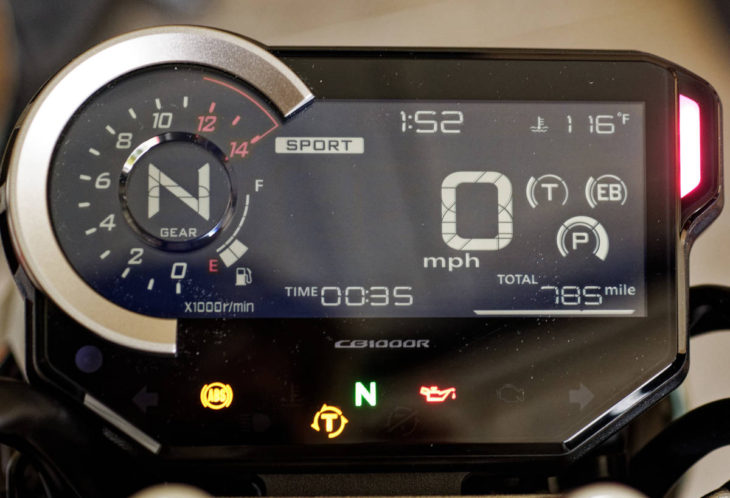
The LCD display (Honda has not moved to the brighter TFT display technology found on some competing models) offers all the information a rider could want in a legible, well organized format. Here you can find, and adjust via handlebar controls, traction control, power mode and even engine braking – each with three levels. Sport, Standard and Rain offer their own default levels of electronic intervention, but there is also a “User” setting that can be completely customized by the rider.
Suspension, brakes and wheels are all good quality stuff. The well-respected Showa SFF-BP fork puts all damping adjustments in the left leg, and spring preload on the right. The rear shock has both spring preload and rebound damping adjustments. Brakes include radial-mount Tokico, four-piston calipers gripping big, dual discs in front. The bike comes shod with Bridgestone’s grippy S21 tires.
The torquey motor and relatively low gearing combine for effortless thrust off the line. The slight lean forward puts the rider in a good position to balance the fierce acceleration from the big engine, and the seat proved comfortable, and supportive, on longer rides.
The new CB1000R is a quick handling machine. Not quite nervous, but always feeling eager to change direction with minimal rider input. The suspension is stiff, and offers a good platform for aggressive riding, without feeling harsh. The transmission makes very positive shifts through the six speeds … we never found ourselves between gears.
When ridden aggressively on twisty roads (or at a track day), the new CB1000R is a very willing participant with the rider. As stated earlier, it changes directions easily , and remains predictable – holding the line selected by the rider faithfully, even when corners get bumpy or unexpectedly change their radius. For the most part, the engine plays along splendidly.
The fly in the ointment is a relatively pronounced flat spot found between 4,500 rpm and 6,000 rpm (see dyno chart borrowed from the Akropovic web site). A good rider may find this frustrating when rolling on the gas exiting corners. It is not so pronounced as to completely halt acceleration in this range, but it is certainly noticeable.
The brakes are good – with plenty of power and decent feel. Certainly up to the standards set by the naked bike category if not the latest superbikes. Good feedback is felt through the chassis from the Bridgestone contact patches on the road.
Vibration levels and sound emitted from the inline-four engine are, for the most part, pleasant. Vibration is there at higher rpm levels, but never unduly annoying. The intake and exhaust note are an improvement, but not up to the standards set by some of the competition (Kawasaki comes to mind).
Throttle turn is long, which can aid the rider in fine adjustment of engine output, but might be too long for some riders’ taste. All of the hand controls, including the clutch and brake lever, are comfortable and easy to use, as are the thumb switches.
The 2018 Honda CB1000R represents a huge step forward in terms of styling. The bike is stunning to look at, and the fit-and-finish is top notch. It handles very well, and includes quality, well-functioning suspension and brakes. Engine performance is strong, but discerning riders may be put off by a noticeable flat spot between 4,500 rpm and 6,000 rpm. Some riders won’t notice it.
Honda has priced the bike at $12,999 U.S. MSRP (the bike is unchanged for 2019, except for color, and carries the same price). This places it between the value leader in the category, the Kawasaki Z900 that is priced at $8,799 (with ABS) and more exotic mounts like the Ducati Monster 1200 priced from $14,995. There is a lot of competition in the naked category these days, and the new Honda may need to rely on its unique styling, and Honda badge, to stand out in the showroom.
See more of MD’s great photography:
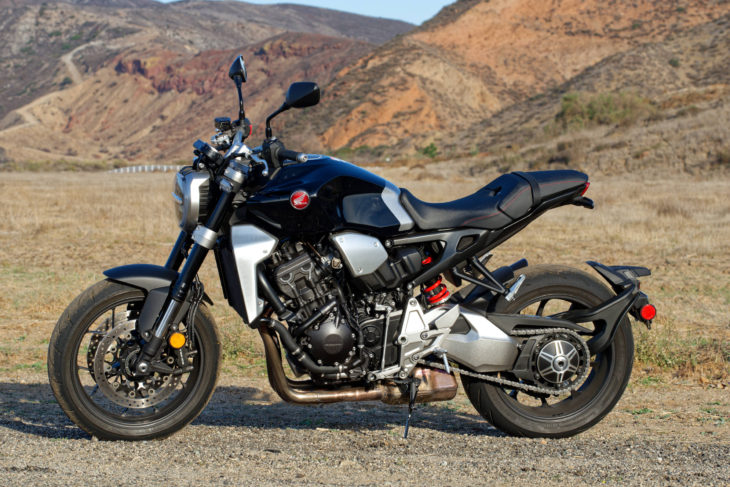
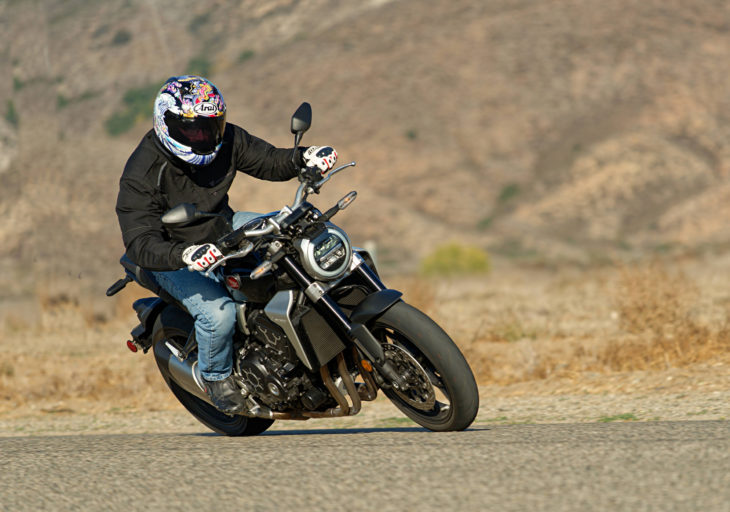

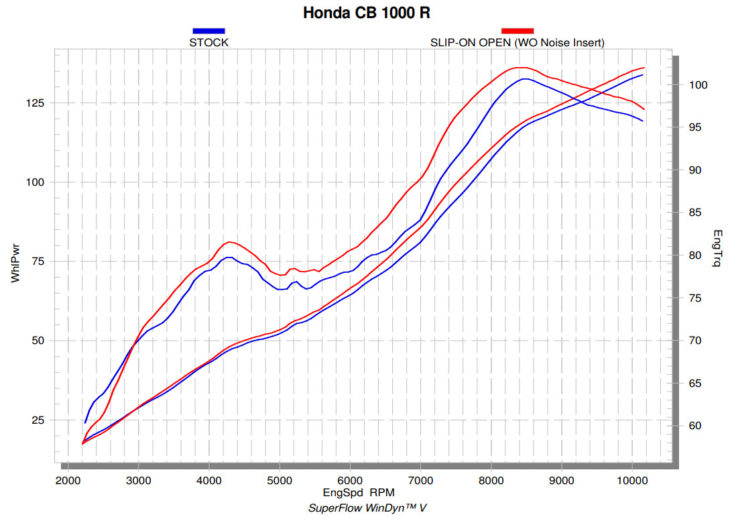
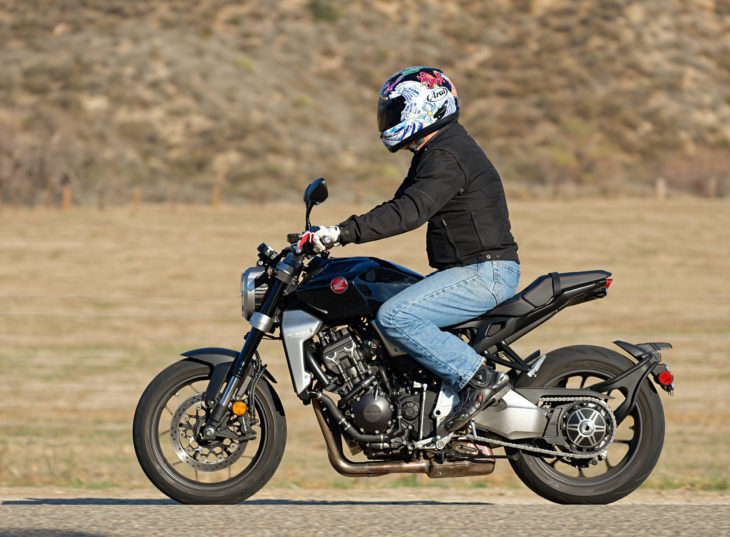
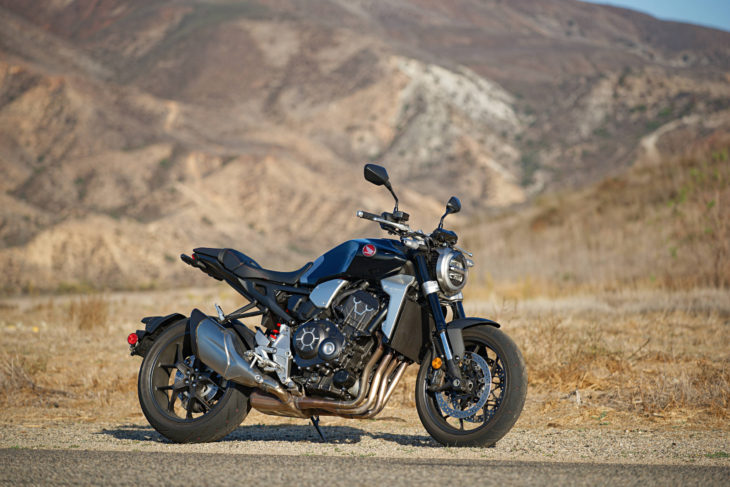






It’s going to be end of mine day, except before ending I am reading this enormous piece of
writing to improve my experience.
At its price point the Kawi z900 cannot be beat. It has one of the smoothest I4 engines ever made, no glitches anywhere and no flat spots. Flat spots are a deal killer for me.
One of my riding buddies has a Z900. He likes it, and I can attest that it gets.
I find the flat spot rather interesting. From reports I’ve read or ride reviews I’ve watched, no mention of a flat spot. Could it be this particular bike? As far as styling goes, I like it till you get to the tailsection or lack thereof. Not a big fan. Funny thing is, Ducati did almost the same look with tailsection on the Scrambler and its wildly popular. Chalk it up to Italian design I suppose. Black was a poor choice for this bike. Thankfully thats been remedied for ’19. And lastly, with all the talk about tank seams, spokes and turds with mustard, I’m curious what the bike of choice is for these people.
Sorry about that. That was me.
I have a ZRX with the most gorgeous tank seam you ever saw. It’s a retro so it makes sense on that bike. Love it.
FLAT “spot” 1500rpm!! F that!
I think that Flat Spot is a FEATURE. I know that’s usually a joke with software development to point at a flaw and call it a feature but preceding that flat spot is a huge spike in torque. Why would Honda do that on purpose? Because you ride a motorcycle differently than when you take pulls on a dyno. There are basically two rev ranges that this bike will be ridden in. One is the RPM of short shifting and commuting. You’ll be in lower RPM’s and have need for as much torque at those short sifting RPM ranges. Think about it. You ride in this rev range 90% of the time. Small changes in throttle will surf this lower peak of torque. When you want to accelerate harder you downshift and raise the rev range to the top of the bikes rev ceiling and surf that wave. So I think they put that spike in there on purpose. If you were to remove it, it would be a flatter profile but I believe they would lose that spike and have a lower torque value for the same RPM. This would translate to a weaker feeling motor at those low rpm situations you find yourself in just going down the road at 45mph in traffic.
Also I love the look of this bike. Sorry for those that don’t get it. This bike looks like a motorcycle for an adult. No alien robot, no bug, no racer boy wannabee. So yes I bought one. Thankful for the choice.
It’s more likely that this flat spot is intentional with the aim of performing well in emissions testing. Flat spots in this rev range predate fuel injection on motorcycles. You’re right about how the bike is ridden. If a rider is really has the skills to ride a bike like this, the flat-spot exists in a part of the rev range that he or she would likely avoid by default (ie. don’t rev that low).
I have the Duc 1200s, the Z900rs and a FZ09. I won’t be adding this one but at least Honda seem to have learned a few lessons from other’s missteps. For the longest time I never went above 5 let alone 6K on the Z900RS and the Duc too stays very happily at 5k or below and I’m booking right along at 70-80+MPH. There was no point during commuting even in 8 lane interstate. So the big-fat torque down there is PERFECT! Now of course, if you want to see the red mist and go like a bat out of hell wind the Duc/Z900 past 7K with big fist-fulls of throttle. Ditto a 1100 v4 Tuono. You’ll find religion right quick or a jail cell.
Trivial swap to GP shift on the honda and relocatable rearsets – hey Ducati, maybe learn a lesson and stop being dicks about such things?
I really wish this craze with truncated rear section would just stop. Offer it as a bolt-on from the factory, sure but kindly stick to sensible and time-tested designs, eh?
How about a relaunch of the 80’s CB1100R on this basic platform? eg. http://kickstart.bikeexif.com/wp-content/uploads/2011/07/honda-cb1100-3.jpg
How about a relaunch of the 80’s CB1100R on this basic platform? eg. http://kickstart.bikeexif.com/wp-content/uploads/2011/07/honda-cb1100-3.jpg
It WAS done for the CB1300, but never got the go ahead, only the naked standard and the F Faired got the nod.
The CB1300 is still a current Honda offering in some Markets.
The dip is about 5% though the curve looks bad but if you compare to some others…. I suspect the major culprit is cam profile and intake – an open can basically did nothing.
see http://images.motorcycle-usa.com/PhotoGallerys/63437877883642233211sb_torque.jpg for curve gyrations despite not having to deal with Euro4. You want to talk about a CRATER in torque curves look no further than Ducati. yikes!
Here’s a quick ’16 vs ’18 on the cb1000r.
https://www.motorcycle.com/blog/wp-content/uploads/2018/08/082118-2019-Honda-CB1000R-hp-torque-dyno-546×388.jpg
Clearly there was a big change made in 2018. How much of the blame can be chalked up to Euro4 vs say bad choice in engine mods I don’t know.
Fantastic! Great review. Thank you. Another new choice for buyers. Why all the CONSTANT nitpicking on EVERY bike shown here in the comments. It’s easy to criticize things I guess. But what a miserable mindset to have about motorcycles or anything. I know there are lots of baby boomers here who talk about bikes from their heyday but those relics would get crucified if reviewed today not to mention all the regulations the manufacturers have to comply with today. I seem to remember a lot of these boomers preaching “if you don’t have anything nice to say just don’t say anything” in their past. So much for that saying for some. Just enjoy all the choices there are and if you do not like a exhaust pipe, or tank with seems, or the font on a letter etc. just keep it to yourself. Good grief.
Love the wheelie shot in the article too! Looks like fun. Keep us posted on more bike reviews and rides. This is one of the best web sites on the Internet.
I’m baby boomer and at the moment got in my garage diferent bikes produced between 1983-2014. Newer, fuel injected machines are nice lively rides, but with more, or less visible fueling issues. If you can compare directly by long term use of both, carbs are smoother off idle and steady on the gas. If you can’t compare, you will just blame baby boomers for telling rubbish and follow marketing mantra: “newer is allways better”.
My collection jumped from 1995,2002-2005 to 2016+ which meant carbs to FI and 2 bikes with fly-by-wire, ABS, LCD screens and all that horse-sh*t. The FI bikes needed reprogramming, one and all at $300-500 each. The throttle connection was incredibly bad. Sure the carbies ran lean but a turn of idle mixture, a clip of needle and the problem was pretty well sorted. Total cost a few dollars and some time.
Despite having the easiest job in the world – clicking around on a computer screen to adjust fueling and engine performance tuning, the factories regularly turn out just unspeakable crap. The latest DUc 821 was atrocious. The 1100 Scrambler was a tad ‘lethargic’ but at least it didn’t surprise and riding it was actually pretty decent even though the ergos were designed by someone with screwball torso/leg relationship. And yet take it to a guy who makes his living tuning engines and in a few days he can somehow fix all the STUPID and still retain all the smog equipment. How is that?
Pegs near crank, raised bars, and close the stupid air gap between back part of seat and wheel. Butt ugly back end.
Not in person. It’s a stunning machine and feels really nice to sit on unlike many other nakeds (coughsFZ09).
What!!??? The FZ09 is about the most comfortable bike i have owned, after I put a Sargents seat on it….lol…but seriously, comfort on a bike is really of a matter of how one fits on a bike. I have smaller friends that think the Ninja 250 was a comfortable bike, to me, it felt like I had toy riding up my butt…..:)
This thing is not good looking in the least. Yes, beauty is in the eye of the beholder and flies have a lot more eyes than humans but really now. This thing is just stupid fugly. Especially the hindquarters. Ugh. Let us just see how many here claim to “love” the styling and “love” the bike and “love” Honda for making it. Will they buy one? Maybe. If so, good for them but for most of us it goes like this:
It’s like putting mustard on a turd sandwich.
It’s still a turd sandwich.
It looks FAR, far better in person, *especially* in “Chromosphere Red” (the 2019 version). Wow, it looks good in that red IRL O.O
Like several bikes of recent vintage, somehow they don’t look good in pictures but they have a presence when actually standing next to them.
That dyno curve makes the Yamaha MT-10 look positively gorgeous!
🙂
I have this bike. I have a few bikes and am a long time rider of most disciplines.
This bike is awesome. Fit and finish, looks are top notch.
Would love more power from it but don’t want it to be louder so I added an Arrow dual titanium silencer but left the quiet inserts in.
You can tell they lowered gearing to make up for the flat spot in the powerband but it will easily wheelie in first and second it wheelies with a tug on the bars above 7,000rpm.
Electronically limited to 140mph and the traction control has baked in wheelie control so if you like mono’s then you need to be in user mode with traction control turned off.
Suspension is good at the front and bad at the back. Front fully adjustable and rear is a rebound only affair, preload aside.
Fuel light blinks for me around 120 to 130 miles which is favorable amongst the more powerful nakeds(why I passed over the MT-10 and Tuono).
This is a heck of a bike. Happy to just look at it, let alone get out and abuse my adrenal gland with some spirited misbehavior.
Well done Honda. You have a convert.
Thanks for the write up Chillis. It is nice to read something that doesn’t sound like a bunch of women shopping for a new dress, but rather some input from someone who actually rides and can be objective.
This bike really appeals to me but I have a few too many in the stable right now.
Give Nitron a call. Even the NTR1 will totally tranform it. One shouldn’t HAVE to fix suspension out of the box but unfortunately the number of recent bikes with tolerable suspension can be counted on 10 fingers or less. There’s just no excuse for getting something that important so utterly wrong. Year after year after model after model.
Passenger seat not “fat chick” approved. My girlfriend said “NO” while sipping on her supersize float to wash down her fifth slice of pan pizza.
Girlfriends come in all sizes. Why not choose a new sport model? Just say’in…
Home Run on the styling Honda! “a huge step forward in terms of styling” This is what a motorcycle ought to look like. But… with all the engineering talent at Honda, you would think they could design a engine that does not have a built in flaw. (Remember the wonderful VFR they ruined with V-Tec?) Fire the guy who signed off on the engine, fix it and they have a winner.
That exhaust system is butt ugly looking at it from the left side. Why do the under-engine mufflers come off looking like truck mufflers?
Again, thanks to the Euros – Euro4 currently.
BLECH.
That’s a catalytic converter. They look bad because pretty stuff burns too easily, I guess..
re: CBF1000 – “Hi, this is a common problem with this bike. After some research I found that it is caused by a valve system to do with the emmissions reduction system on the bike. It does something along the line of pipe exhaust back into the engine or something similar while the bike warms up to reduce emissions, I have read about guys blocking off this hose and apparently this solves the problem. I personally just ride to it, after having the bike for 2 months have learnt this quirk and adjust my riding style to match. If you are still unsure, come to the honda cbf1000 forum. I know I have seen this topic there before with explanations.”
Honestly, that looks like a terrible torque curve to me, at least for anything not intended as a race bike (but there where’s the rest of the power). 2000 rpm wide flat spot. Look at where the torque peaks the first time – it’s 2000 rpm later before it reaches that level again. Yeah, if you want any sort of brisk acceleration, better keep it above 6500 rpm.
And yeah, I was probably one of the guys wondering where all the peak HP went on the Z900RS. Though, in that case they sacrificed quite a bit of top-end power for a slightly meatier low end and midrange. Slightly. The regular Z900 already had a nice even torque curve. But this bike, it looks like they absolutely killed the midrange with little real benefit on the top end. Seems like a poor trade-off for the type of bike it is.
While a flat mid-range might be acceptable on a litre bike that produces 150+ RWHP, in this application, with this much (still quite a bit, to be sure) peak HP, it seems unacceptable.
1. Oh ! Please excuse us. We still have to finish the bodywork, especially at the rear.
2. Do you REALLY think we will offer a bike looking like that to the customer ?
3. Well……..at least we got the engine in the frame !
4. ….ad nauseum !
I am a huge fan of Hondas, and I really wanted to love this bike. Upon sitting on it, however, I discovered that the heel of my right foot tends to run into that shiny exhaust system, plus the seating position requires a forward lean that is far too aggressive for my reconstructed neck.
Then I read about the motor. For all of Honda’s talk of 143 hp, increased compression and torque, and just plain more power everywhere vs the previous model, this real-world dyno run of an American-spec model belies nearly all of Honda’s claims…
https://www.motorcycle.com/blog/wp-content/uploads/2018/08/082118-2019-Honda-CB1000R-hp-torque-dyno-546×388.jpg
143 hp at the crank normally results in roughly 130 at the rear wheel on a chain-driven motorcycle. This Honda barely touches 120 rwhp, and only for the briefest moment. Otherwise, this new model makes substantially less hp and torque than the old model. Moreover, it makes much less hp and torque in the midrange, which is right where you would want the power and torque on a standard-styled sportbike. This is also right where Honda claimed to have beefed up the motor the most.
Compare this power curve with the ultra-linear curve of the XSR900 or any of the Z900 Kawasaki variants, all of which also have to deal with modern emissions requirements, and it’s clear that Honda well and truly screwed the pooch here. Not only does this model not deliver on Honda’s claims of improved power output and low-down punch, it actually falls well below the model it replaces.
For all of that, Honda is asking $12,999, vs $8799 for a Z900 ABS that makes more power where it matters most, and just about as much power on top, with less buzzy vibration, while offering the same weight and similar handling?
Yep, considering the much less expensive choices that are available right now, someone is seriously going to have to love the looks and build quality of this new Honda in order to justify that $13K cost of admission.
Yeah, what you said!
The Kawasaki has an adjustable rear suspension as well.
sure, it’s adjustable but that Z900 shock is the worst thing I’ve ever felt. The -RS shock is better but still only ‘tolerable’. Between K-Tech and Nitron the results are nothing short of dramatic.
Yep. The Z900 suspension is definitely bargain basement, both front and rear. Couple that with the absolutely crappy stock tires and one understands why it sells for what it sells for.It also has a lack of electronic dohickeys which keeps it at a price point. This is actually a plus. Oh, and the ergos suck also. That recall for the broken shock mount doesn’t help either.I owned one for a while and regret the purchase. It’s in my top three worst bikes I’ve ever owned. This Honda is sorta/almost nice looking, but the ergos look like crap. A 30 minute ride at best. After which your knees will be screaming for mercy and your wrists, elbows and shoulders will beg you not to get back on.
What are your complaints about the suspension? The thing about an adjustable suspension is that you can adjust them. If your bike is diving or wallowing in turns enough to hold you back, tighten it up. If it’s jolting you too much or not tracking over bumps, loosen it. If you don’t understand how preload and rebound damping affect the bike, do some googling. I have to imagine you can fiddle with your bike to get it to suit your riding. I have a Z800 and have fiddled with mine over time to settings that suit me just about perfectly.
How do the ergos suck? Did you come from a different type of bike before the Z? I do think Kawasaki tends to make their seats lower than they should be to get shorter riders comfortable at the expense of leg room. I have a beaded seat cover on my Z800 that raises my butt a bit, I think that helps. I rode it on a 2,000 mile round trip from Atlanta to Austin and back, definitely more than 30 minutes. If you look at a standard and think the ergos look like torture, I have to imagine you’re in pretty rough shape physically.
If you want a soft suspension, bolt upright posture, and lots of legroom you’re looking for an adventure bike. Nakeds are set up for moderately aggressive road riding, that means slight lean over the front end and firmer suspension.
True but the Honda is a Honda. You notice it when you see and sit on it. It’s a museum piece. It’s also more comfy than the ZED900 in terms of seat/bars/pegs. But I am absolutely a ZED9 fan.
I find the Z900 to be slightly more comfortable than the CB1000R. The CB has more legroom, but the Z900 has higher, closer bars. Also, I suspect that the Z has slightly better wind protection due to that tall, bulbous tank and tiny windscreen, plus most reviews describe the Kawi as being smoother/less buzzy than the Honda.
All in all, I’m fairly certain I would rather do a 500-mile day on the Kawi.
In terms of the museum piece thing, or the build quality, yep, it’s no contest. The Honda kills the Kawis there, including the Z900RS. No contest, no debate.
I hate what they are doing to bike’s rear end these days. What’s the matter with a proper dual seat and even possibly (shock horror) a mudguard to keep the crap off you.
Yes. I really enjoyed the picture of boy with good knees bent back just like a HERO race bike racer on a street bike. Remindes me of Japan 1967. PUT the pegs near the crank. —- Over. Oh yea sitting on his nuts for fun.
What, that’s not fun?
How small is this bike? Unless the rider in the pictures is a giant, the bike looks incredibly small.
I’m 6-3 and north of 200#. My R1150GS and Guzzi 1100 Quota didn’t look small under me, but they sure didn’t look big. KTM’s 950 Adventure fit me like it was personally sized.
I’d take the Z900RS over this new Honda any day. The CB’s appearance is polarizing, even chaotic/incomplete, a never heard response to the big Zed, whose flat torque and smoother vibes are also welcome. I’d trade a fatter torque curve for a few peak HP on any street bike.
Likely the heel of my size 13 boot interferes with the honkin’ muffler on this CB, too.
Many new nakeds populate showrooms, but few true modern renditions of the almost universally beloved UJM/universal Japanese motorcycles of yore. One guy would transform his UJM into a chopper, the next guy a café, the next guy is touring cross continent, hybrids of all the above, and cost for such mods were moderate. This CB might need a entire new rear sub frame to carry moderate luggage or average sized adult passenger.
The only modern renditions of the original UJMs that come to mind are the CB1100, the big Zed, and maybe Honda’s 500 parallel twins.
IIRC Kawasaki’s coming naked 400 twin has a huge seat step, but I might be wrong.
Is the dual height seat more the result of styling goals, for shorter legs to reach the street, or ratios of both? It’s funny how we just took flat seats for granted when that’s pretty much all we ever saw.
Of course I’m biased. With 34″ inseam, as mentioned above, KTM’s 950 Adventure was a perfect fit.
“Is the dual height seat more the result of styling goals, for shorter legs to reach the street, or ratios of both?”
I think both but almost every single bike has a slant towards the “shorter legs” part. Which puts yer nuts into the tank – or in this one’s case, they seem to have recognized the problem and padded that part a bit.
My custom seat transformed my bike – less knee bend, no constant pushing myself back from the tank, and still nice reach to the ground. This ain’t just this Honda; it’s most bikes….
I guess a tank bag and backpack will be the next thing you shop for after buying this bike. Otherwise there is no provision for taking along anything with you.
Doesn’t appeal to me visually but I’m sure it’s a nice bike
WHAT IN Hell is wrong with Honda ! ! ! The days of mid range flat spots should of been over 10 years ago. Then to have ‘ almost ok ‘ issues too. Geez Louise ! The coal shovel cans and STILL in line 4 VIBES to get used too . No thanks . WAKE UP HONDA !
Tight (and in Honda’s case, always interpreted as tightly as possible) noise and emission regs, tune for high top end power and styling limited airbox volume and flow, all contribute to a midrange flat spot. With RbW, I bet Honda could, if they really wanted to, somewhat hack around it with crazy, compensating “active” throttle maps, but only at the cost of removing all connection between a rider’s wrist and what the butterflies are doing, hence how the engine is responding.
BS. Air box resonance, style, emissions requirements, 4 cylinder inline buzz, etc. are controlled by other manufacturers, well perhaps not the designer style influence, and for a hell of a lot less money.
But, under euro 4, rarely if at all, without excessive RbW trickery.
You can do all kinds of stuff, if you don’t care at all about what a rider’s wrist is doing. Only treating it as a mild suggestion, that you may attempt to, averaged over a few seconds, bother fulfilling. Makes bikes, and cars, objectively “good,” and certainly “smooth.” But dull, lifeless and remote as all whatnot.
The 5-6000rpm stumble exists because that’s the engine speed that the regulatory bodies use for their emissions tests, therefore most motorcycles have an intentional lean condition in that rev range. Carbs, E.F.I., doesn’t matter. It’s easy to fix, it’s just a shame that it has to cost money to do so. That flat spot has been a little gold mine for companies that make E.F.I. accessories and jet kits for years.
I am sure this I4 doesn’t buzz any more than any other.
OK, dumb question: Why are graph hp and torque crossing at approximately 9400 rpm instead of 5250? Could it be because different (unstated) units are used in the graph? What ARE the units? If they truly are rwhp and ft-lbs., that’s a pretty impressive engine for a naked. As stated, the price puts it at a serious disadvantage to the Kaw.
“OK, dumb question: Why are graph hp and torque crossing at approximately 9400 rpm instead of 5250? Could it be because different (unstated) units are used in the graph? What ARE the units?”
Was looking at that graph and thought someone had slipped me a Mickey, as I could not make sense of it, either. Hope someone can answer your (our) questions on that!
Looks like _Wheel_ Horsepower, vs _Crank_ Torque in Newton Meters…..
Kilowatts and Newton meters graphed would intersect at 9549 rpm.
Nice catch… what are the odds that actually the hp curve is the linear one and the other one is the torque….?
Notice how torque actually starts at 60, so if you actually graph it from 0 to 100 it would become more “standard torque like curve”.
Yes, that’s the actual reason, those graphs are really weird but a search shows SR1000R graph looks the same
https://duckduckgo.com/?q=akrapovic+cb1000r+dyno+chart&t=ffab&atb=v137-5&iax=images&ia=images&iai=http%3A%2F%2Fwww.moorespeedracing.co.uk%2Fuser%2Fcategories%2Fthumbnails%2FBMW%2520S1000RR%252010-14%2520AKRAPOVIC%2520DYNO%2520GRAPH.jpg
Yes, it’s the units. Nothing magical about 5250rpm, it’s just down to the units commonly used for torque and hp.
I believe the HP and torque do not cross at 5250 because the torque and HP are using different scales. Note the left and right side of the graph.
I think you got it, Tonyh, I clicked on the graph to enlarge it, “eyeballed” moving the torque curves up to line up the “75” axis for both hp and torque, and both same-color curves cross at about 74 for both torque and hp at 5250 rpm. So, the units do appear to be “wheel” horsepower and foot pounds. Good cipherin’, as Jed would say.
I would have thought the aftermarket pipe might help the flat spot, but as someone above states, it may be a lean fueling issue (done on purpose to meet emissions), and with electronic fuel injection, better breathing doesn’t necessarily mean more fuel, those carbureted days are gone. It would be interesting to see what would happen with the aftermarket pipe and a remap, but that’s probably a “closed course” thing these days. Electric bikes (at least one day) may be an improvement over gub’mint hobbled IC performance.